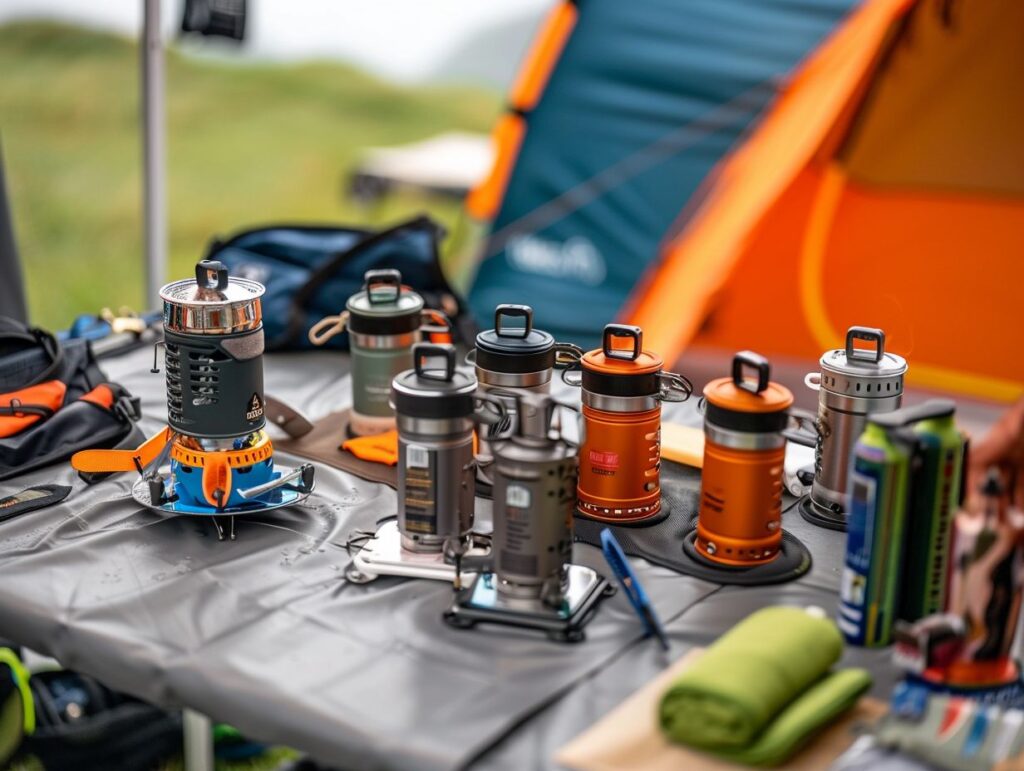Planning a camping trip? One of the most important items to consider is a portable camping stove. With various factors to think about, such as size, weight, fuel type, cooking power, and durability, choosing the right stove can make a big difference in your outdoor cooking experience.
We will discuss the factors to consider when selecting a portable camping stove, the different types available, how to properly use one, and some tips for choosing the best stove for your camping needs. Let’s get started!
Key Takeaways:
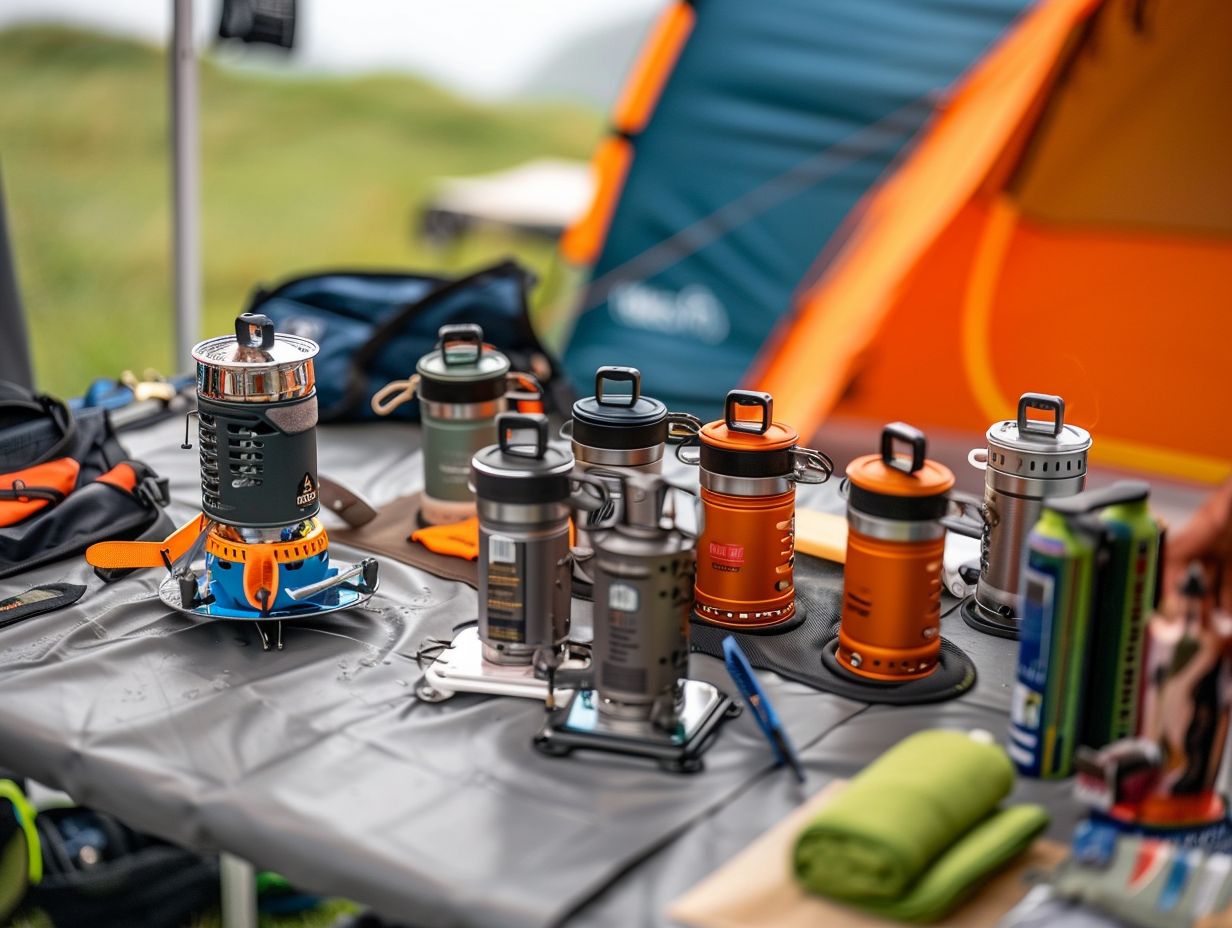
- Consider size, fuel type, cooking power, durability, ease of use, and price when choosing a portable camping stove.
- Types include canister, liquid fuel, wood burning, solid fuel, and alcohol stoves.
- Properly set up and maintain your stove, and choose one that meets your camping needs, has good reviews, and comes with quality accessories.
Factors to Consider When Choosing a Portable Camping Stove
When choosing a portable camping stove, it is crucial to take into account several factors such as:
- Size and weight
- Fuel type
- Cooking power
- Durability
- Ease of use, and
- Price
These considerations are essential to select a stove that aligns with your particular camping requirements, whether they pertain to car camping or backpacking.
1. Size and Weight
When selecting a camping stove, the dimensions and weight play a crucial role, particularly when considering its intended use for backpacking, where each ounce becomes significant. Compact designs present the benefit of being lightweight and easily portable, making them well-suited for backpacking excursions characterised by limited space.
The smaller size of these stoves allows for effortless packing within a backpack, reducing bulkiness and facilitating efficient storage during trips.
In contrast, camping stoves tailored for car camping purposes typically feature larger dimensions and heavier builds. While these stoves provide expanded cooking space and enhanced stability, they sacrifice some level of portability.
A comparison between backpacking stoves and car camping stoves reveals that the former emphasise compactness and lightness, while the latter prioritise cooking capacity and overall convenience.
2. Fuel Type
The selection of the appropriate fuel type for a portable camping stove, whether propane or butane, can have a notable impact on both the cooking process and the environmental implications.
Propane is distinguished by its extensive availability, rendering it a convenient choice for camping excursions due to its widespread presence in outdoor supply stores and petrol stations.
With a lower boiling point compared to butane, propane exhibits reliable performance even in colder environments. However, the higher pressure requirements of propane may result in a bulkier load during transportation.
In contrast, butane offers a more compact and portable option, facilitating ease of transport. While butane tends to vaporise more effectively in warmer climates, it may encounter challenges in colder weather conditions.
3. Cooking Power
The cooking effectiveness of a camping stove is typically quantified in British Thermal Units (BTUs), which denotes the level of heat emission from the burners.
The BTU rating of a stove significantly influences cooking durations and efficiency. Higher BTUs facilitate rapid heating and cooking, making them well-suited for swiftly boiling water or achieving optimal searing of meats. Conversely, stoves with lower BTU ratings may face challenges in promptly attaining desired temperatures.
The quantity and type of burners are pivotal in attaining precise cooking outcomes. The presence of multiple burners enables multitasking and adjustment of heat levels, whereas varying burner types, such as simmer or high-heat burners, provide flexibility to accommodate diverse cooking requirements.
4. Durability
When choosing a portable camping stove, it is essential to prioritize durability to ensure it can endure the demands of outdoor activities and diverse weather conditions.
High-quality camping stoves are typically constructed using materials such as stainless steel or aluminium to enhance their resilience. These materials offer both lightweight properties for ease of portability and resistance to corrosion and rust, thereby extending the stove’s longevity.
Additionally, features like reinforced hinges and sturdy handles play a crucial role in enhancing the overall robustness of the stove. These attributes enable the stove to withstand strong winds and rough handling during outdoor excursions, ultimately enhancing its reliability and usability in challenging environments.
5. Ease of Use
A portable camping stove should possess user-friendly attributes, including uncomplicated ignition mechanisms and controls to facilitate a seamless cooking experience.
For example, Piezo ignition systems offer a simplistic push-button ignition process that eliminates the necessity for matches or lighters, providing convenient and swift setup. Conversely, manually ignited stoves may entail additional steps such as utilising a lighter or fire starter, which, although more intricate, offer reliability across diverse environmental conditions.
Stoves equipped with adjustable flame controls enable users to finely adjust the flame’s intensity for precise cooking, while straightforward assembly features ensure that setting up the stove is effortless, even for individuals unfamiliar with camping equipment.
6. Price
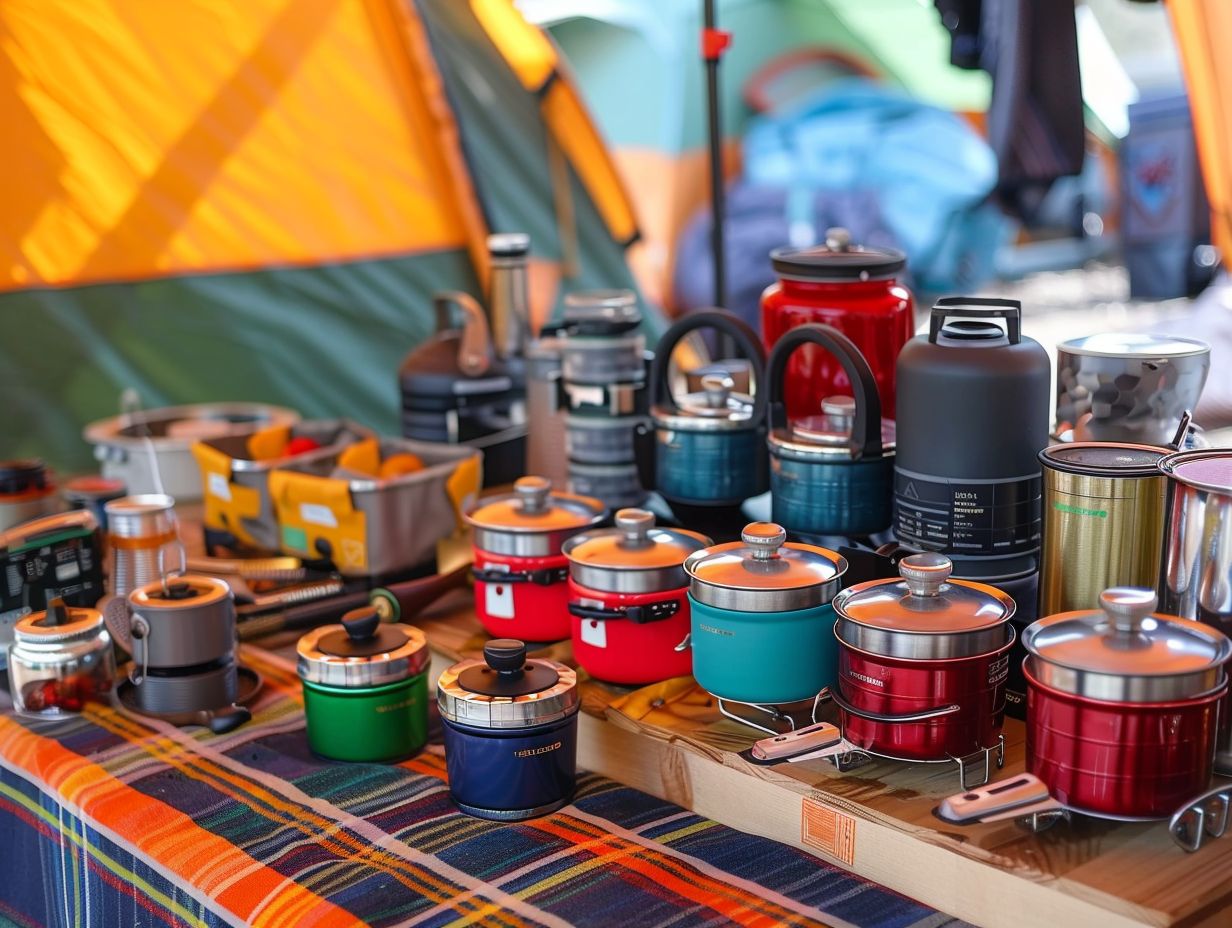
The cost of a camping stove can vary significantly based on factors such as its features, brand, and the accessories included with it. For example, a basic model may be priced affordably but could lack additional features such as windshields, carrying cases, or fuel canisters.
In contrast, premium camping stoves typically come with these accessories included, providing added convenience and value for individuals who enjoy outdoor activities.
Although choosing a more expensive option at first may appear intimidating, the supplementary accessories can improve the stove’s functionality, making it a valuable investment for frequent campers or backpackers who prioritize efficiency and durability.
Types of Portable Camping Stoves
Portable camping stoves are available in a variety of types, each utilising distinct fuel sources and tailored to specific groups and camping environments.
1. Canister Stoves
Canister stoves are widely favoured for their convenience, utilising pre-pressurised canisters that are typically filled with either butane or propane. These stoves are particularly esteemed among campers and outdoor enthusiasts due to their user-friendly nature.
Their straightforward design allows for swift setup and instant flame, catering to the needs of individuals seeking quick cooking solutions while on the move. The compact dimensions and light weight of canister stoves render them especially suitable for activities such as backpacking expeditions or outdoor picnics.
One aspect that merits consideration when using butane canisters is their performance in colder climates. In such conditions, the fuel within these canisters may encounter difficulty in vaporising efficiently.
Conversely, propane canisters demonstrate enhanced performance in colder environments, albeit at the expense of being bulkier and marginally heavier than their butane counterparts.
2. Liquid Fuel Stoves
Liquid fuel stoves are renowned for their versatility, as they have the capability to burn a variety of liquid fuels, rendering them a dependable choice for international travel and challenging environmental conditions.
Common types of liquid fuels utilised in these stoves encompass paraffin, white spirit, and diesel, with select models boasting compatibility with unleaded petrol. This broad spectrum of fuel options guarantees users the ability to procure a suitable fuel irrespective of their geographic location.
The widespread availability of these fuels globally positions liquid fuel stoves as a pragmatic choice for activities such as camping, backpacking, and emergency preparedness.
Moreover, their capacity to deliver optimal performance in cold climates and at high altitudes further cements their reputation for reliability, ensuring consistent heat output in the face of varying environmental exigencies.
3. Wood Burning Stoves
Wood burning stoves provide an environmentally-friendly alternative by utilising natural materials such as wood and twigs as fuel. During operation, a wood-burning stove facilitates the combustion process internally, producing heat that effectively warms the surrounding space.
These stoves are engineered to optimise burning efficiency, resulting in minimal smoke emissions. Consequently, they offer a sustainable solution for heating purposes while diminishing dependence on fossil fuels.
In outdoor settings, wood-burning stoves prove to be versatile and practical tools, suitable for various activities including cooking meals, boiling water, and providing warmth in cold wilderness settings. To ensure responsible usage, it is essential to evaluate the availability of wood in the camping area and adhere to any regulations pertaining to open fires.
4. Solid Fuel Stoves
Solid fuel stoves are characterized by their compact and lightweight design, rendering them highly suitable for ultralight backpacking purposes. These stoves are typically utilised with solid fuels such as hexamine tablets, wood pellets, or fuel cubes, chosen for their high energy density within a small form factor.
The straightforward nature of solid fuel stoves ensures ease of operation, requiring minimal setup and maintenance. It is worth noting that solid fuel stoves may generate a higher amount of smoke and residue in comparison to alternative camping stove variants. This aspect may raise concerns in regions with fire restrictions or during instances of stealth camping.
Notwithstanding this drawback, the reliability and user-friendly attributes of solid fuel stoves contribute to their widespread popularity among outdoor enthusiasts.
5. Alcohol Stoves
Alcohol stoves are known for their simplicity and lightweight design, utilising denatured alcohol as the primary fuel source, thus making them a favoured choice among minimalist campers. These stoves function by filling a small reservoir with alcohol, which is then ignited to generate a consistent flame for cooking purposes.
An inherent advantage of alcohol stoves lies in their notable fuel efficiency, as they tend to burn cleanly and with minimal wastage. Consequently, they are recognised as environmentally friendly and cost-effective alternatives for outdoor culinary activities. However, it is worth noting that alcohol stoves may exhibit slower cooking times relative to certain other stove varieties.
Furthermore, the availability of denatured alcohol might exhibit variability based on location, underscoring the importance of meticulous fuel resupply planning for campers.
How to Properly Use a Portable Camping Stove
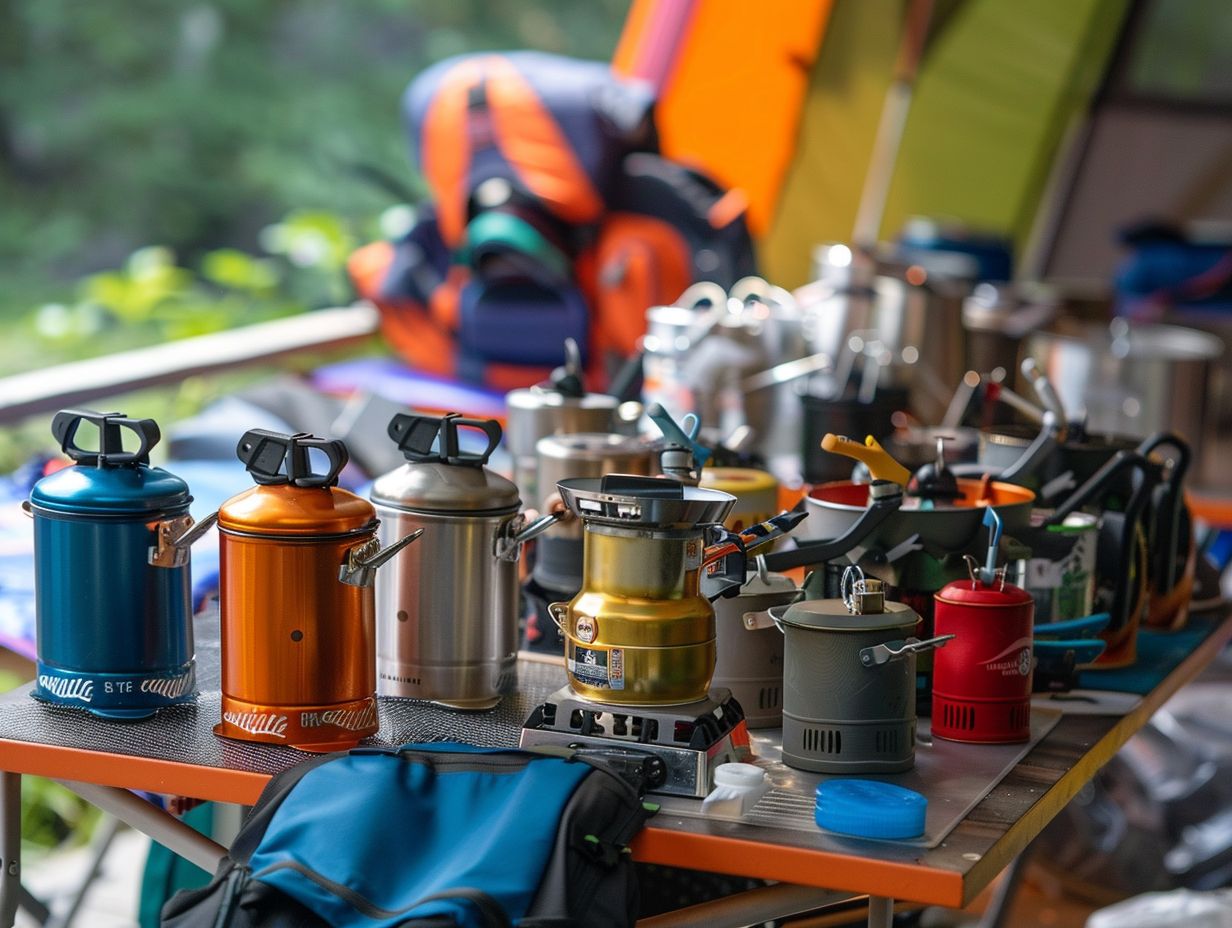
The correct use of a portable camping stove is essential for safe and efficient cooking in outdoor settings, ensuring the ability to prepare meals without facing any hazards.
1. Set Up the Stove in a Safe Location
It is imperative to establish a safe location for setting up a camping stove to prevent accidents. Ideally, the location should be sheltered from the wind to improve wind resistance.
Selecting a level and stable surface, free from flammable materials, is crucial to ensure the stove’s stability during cooking. Placing the stove on uneven or rocky terrain can result in hazardous tipping.
To protect the stove from wind interference, it is advisable to utilise a collapsible windscreen or create a natural barrier using rocks or trees to serve as a windbreak. This not only stabilises the flames for effective cooking but also mitigates the potential risks of accidental flare-ups triggered by sudden gusts of wind.
2. Follow the Instructions for Your Specific Stove
Adhering to the manufacturer’s guidelines for your specific camping stove, including ignition types and burner usage, is essential for proper functionality and safety.
Understanding the correct ignition process is critical in order to prevent accidents and ensure a seamless cooking experience during outdoor excursions.
When operating the burners, it is important to carefully adjust the flame settings to prevent overheating or irregular cooking. Thoroughly reading the manual is crucial to acquaint yourself with the stove’s features and safety precautions.
Proficiency in troubleshooting common problems, such as gas leaks or burner obstructions, can help mitigate frustration and potential hazards while camping.
3. Clean and Maintain Your Stove
Consistent cleaning and maintenance of one’s camping stove, along with its accompanying accessories, are imperative to guarantee its durability and reliable operation. In the process of cleaning a camping stove, the initial step involves the removal of all detachable components, such as the burner, fuel line, and control valves.
Subsequently, these parts should be immersed in warm, soapy water to eliminate any accumulated dirt or residue. A soft-bristled brush can then be used to remove any stubborn debris. Vigilance towards identifying any signs of deterioration, such as rust or loose fittings, is crucial, as these factors could potentially hinder the stove’s performance.
Following the cleaning process, it is essential to ensure that all components are thoroughly dried before reassembling the stove. To prevent corrosion, the camping stove should be stored in a cool, dry location, protected from direct sunlight and moisture.
Furthermore, the use of accessories like a carrying case or storage bag can significantly help in protecting the stove during both transportation and storage.
Tips for Choosing the Best Portable Camping Stove
Choosing the best portable camping stove requires a detailed examination of your specific camping needs, thorough review analysis, brand comparisons, and the acquisition of high-quality accessories.
1. Consider Your Camping Needs
When choosing a camping stove, it is essential to carefully consider your specific camping requirements. This includes factors such as the size of your camping group and whether you require a compact stove for backpacking purposes or a larger stove for group camping settings.
For solo camping excursions, compact stoves offer notable advantages due to their lightweight design and ease of portability. These stoves are particularly well-suited for individuals seeking to minimise pack weight and optimise space utilisation.
Conversely, group camping expeditions typically necessitate larger stoves that can efficiently cater to the cooking needs of multiple individuals. It is imperative that the size of the stove corresponds to the group size to ensure that everyone’s cooking requirements can be fulfilled without extended wait times or limitations on available resources.
2. Read Reviews and Compare Brands
Researching reviews and comparing well-known brands such as Camp Chef, Coleman, and Primus can help individuals in identifying the most suitable camping stoves that align with their specific needs. User reviews play a pivotal role in presenting practical insights concerning the functionality and dependability of these stoves.
By examining feedback from fellow outdoor enthusiasts, valuable details regarding aspects like longevity, user-friendliness, and fuel efficiency can be obtained. Camp Chef is recognised for its versatile cooking capabilities and robust construction, whereas Coleman provides cost-effective alternatives known for their dependable performance.
On the other hand, Primus garners acclaim for its compact design and utilisation of premium materials. Engaging in a meticulous review analysis process can help in making a well-informed decision rooted in the stove’s features, dependability, and pricing structures.
3. Test Out the Stove Before Your Trip
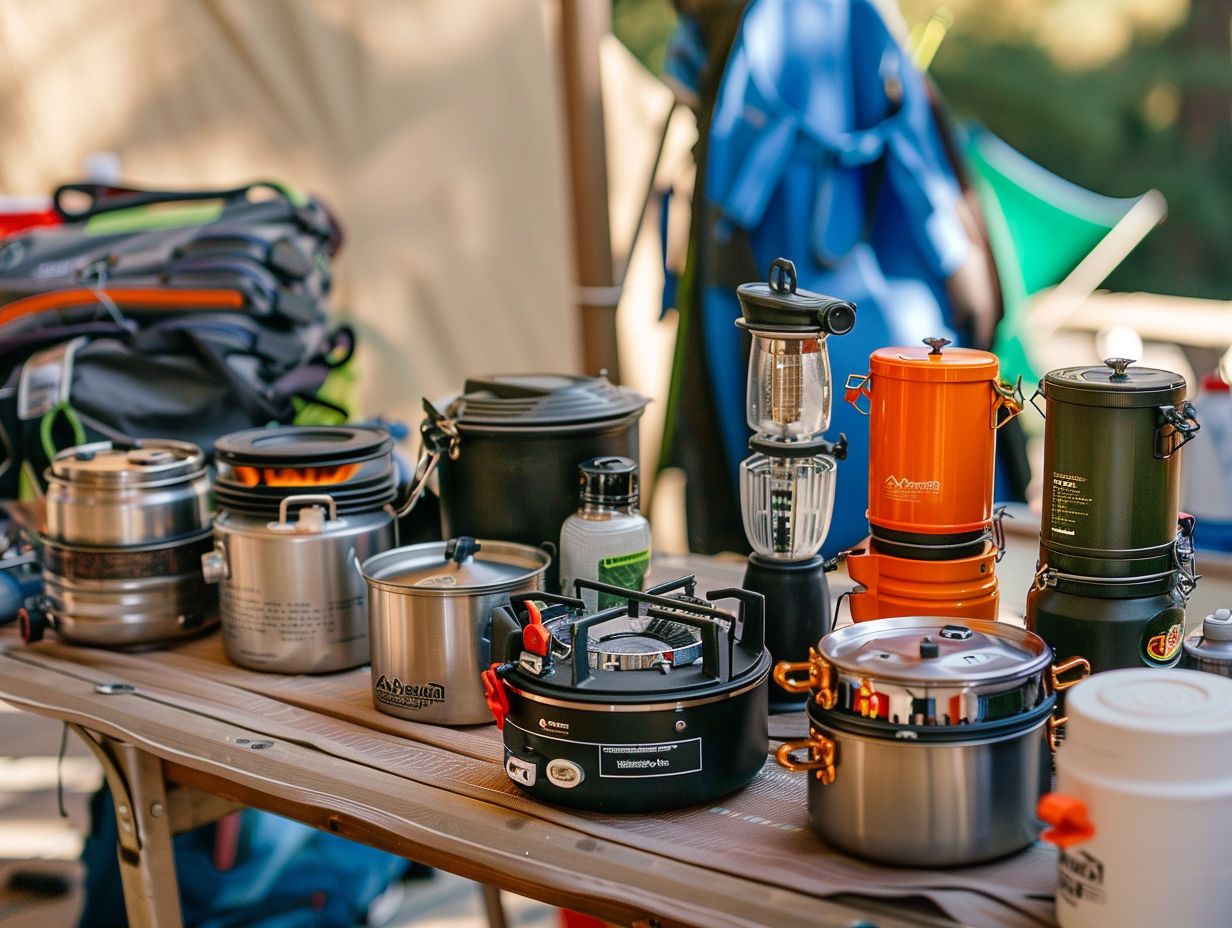
It is advisable to carry out a thorough test of your camping stove before setting off on your trip. This preliminary step ensures that you are adequately familiar with the stove’s setup, various ignition types, and cooking capabilities.
Carrying out a trial run enables you to practise lighting the stove safely, an essential aspect to mitigate any potential accidents when in a wilderness setting.
Moreover, adjusting the burners during the test allows you to understand how to control the heat output for different cooking requirements. The practical experience of cooking a simple meal during this trial aids in assessing the stove’s efficiency in real-life scenarios.
During the test, it is important to be mindful of common issues that may arise, such as uneven flames, potential clogs in the fuel line, or challenges in regulating the temperature. Identifying and addressing these issues beforehand can significantly enhance your overall cooking experience during your camping trip.
4. Invest in Quality Accessories
Quality accessories are a valuable investment that can significantly improve your cooking experience and complement your camping stove, leading to increased efficiency and environmental friendliness.
Wind guards are essential accessories designed to shield your flame from sudden gusts of wind, ensuring a steady heat supply for your cooking needs. Additionally, carrying cases offer both organisation and portability, facilitating the hassle-free transportation of your camping stove and associated accessories.
Equipping yourself with the appropriate cooking utensils, such as spatulas, tongs, and knives, can simplify meal preparation tasks like grilling, sautéing, or boiling. These accessories not only enhance convenience but also promote sustainability during camping trips by reducing waste and optimising resource utilisation.
Frequently Asked Questions
What factors should I consider when choosing a portable camping stove?
When choosing a portable camping stove, you should consider factors such as size, fuel type, weight, and cooking power. These will determine the stove’s portability, versatility, and functionality for your specific camping needs.
What are the different types of fuel options for portable camping stoves?
The most common types of fuel options for portable camping stoves are propane, butane, and liquid fuel (such as white gas or kerosene). Some stoves also offer the option to use wood or solid fuel tablets. Each fuel type has its own advantages and disadvantages, so it’s important to consider your needs before choosing a stove.
How important is the weight of a portable camping stove?
The weight of a portable camping stove is crucial, especially if you plan on carrying it during your trips. Stoves with lighter materials and compact designs are more suitable for backpacking, while heavier stoves may be better for car camping. Consider the weight and size of the stove when making your decision.
What cooking features should I look for in a portable camping stove?
The cooking features of a portable camping stove can vary greatly. Some stoves have just one burner, while others have multiple burners and even a grill or griddle option. Think about the types of meals you will be cooking and choose a stove with the appropriate features to make your camping experience more enjoyable.
How can I ensure the safety of using a portable camping stove?
To ensure the safety of using a portable camping stove, always follow the manufacturer’s instructions and guidelines. Choose a stable surface to place the stove on, never leave it unattended while in use, and make sure to properly turn off the fuel supply. Also, be cautious when handling hot surfaces and fuels, and always have a fire extinguisher or water source nearby.
Can I use a portable camping stove for indoor cooking?
No, portable camping stoves should only be used outdoors in well-ventilated areas. They produce carbon monoxide, which can be dangerous if inhaled in enclosed spaces. Never use a camping stove inside a tent or any other enclosed area.

